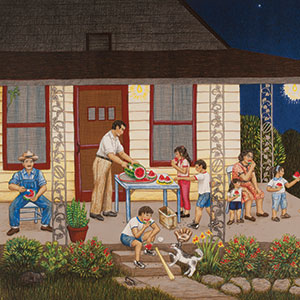Arts
'The House Imaginary' at SJMA
 In 'Sandia,' by Carmen Lomas Garza, a family spends an idyllic summer evening on the porch.
In 'Sandia,' by Carmen Lomas Garza, a family spends an idyllic summer evening on the porch.
I was lucky enough to be in Los Angeles during the 2014-15 retrospective of Larry Sultan's photography at the Los Angeles County Museum of Art. "Larry Sultan: Here and Home" featured images from three of the artist's series. While The Valley consisted of comical, salacious outtakes from a porn shoot, the photographs of his parents in Pictures from Home cast a lasting and more resonant spell. In the first chapter of his book of the same name, Sultan wrote, "I want my parents to live forever."
As Sultan prepared to mythologize his parents on 28 rolls of film, he spent the day "scavenging, poking around in rooms and closets, peering at their things, studying them." One of those images, Mom Posing by Green Wall and Dad Watching T.V. (1984) appears in the new San Jose Museum of Art exhibit "The House Imaginary." The curator Lauren Schell Dickens has assembled a survey of contemporary artists whose work, like Sultan's, pokes around and peers inside actual houses in order to de- and reconstruct our memories of home.
Todd Hido, a photographer based in San Francisco, is the kind of artist amateur photographers aspire to become. He seems bent on discovering the meaning of America by studying and then taking pictures of our infinite suburban sprawl. His high-definition print #2523 from the series "Outskirts" was also published in book form as House Hunting (2001). They are portraits of homes lurching about in a David Lynchian darkness. Artificial light from street lamps gives life to shadows made by winter trees. Ugly telephone poles and wires constrict a view of the night sky. Windows are illuminated, but it's impossible to see inside, to even catch a glimpse of a human figure. Hido captures these bleak, deserted places where the façades are as unwelcoming and impenetrable as the faces hiding somewhere inside.
Won Ju Lim (a bicoastal artist by way of Boston and Los Angeles) is an ideal choice for a house-themed exhibit. In 2015, San Francisco's Yerba Buena Center for the Arts hosted her work Raycraft is Dead, which featured a model house spinning down onto a platform below. When I spoke with her then, she explained that the piece was a commentary on her strained relationship with a neighbor who picked avocados from her trees without asking. Her personal boundaries now appear to be happily restored with Kiss D7 (2015), a gorgeous abstraction of an architectural plan made of plexiglass and light. Two white boxes hang on the wall as Klimtian colors—orange-golds and celadon—form intricate patterns that suggest windows, doors and walls, but diaphanous ones that are gateways to a perfect world.
Two different Carmens with two very different practices both catch the eye. Carmen Lomas Garza, born in Texas but now a San Franciscan, is represented by a lithograph entitled Sandia. Under an awning on a hot summer night, a father carves up a watermelon for his family to share. Their brightly lit front porch keeps the blue-black sky at bay. Garza paints a swinging bench and flowers in the front yard the same watermelon-red that emphasizes a harmony within the group. Carmen Argote on the other hand has three of her Folding Structures on display. Made from papier mâché, paint and acrylic plastic core, they are versions of household items like ironing boards, sheets and towels but transformed by minimalism. They could be items from a Martha Stewart catalogue if Martha Stewart had abandoned all sense of practicality and utilitarianism.
Salomón Huerta who, for a time, painted the backs of people's heads to challenge the notion of portraiture has more recently turned to painting houses. An untitled oil on canvas shares the same Los Angelean blues and greens as a David Hockney. His palette may be similar, but his details are not. This painting is busy with tall cypress in the background and amorphous green bushes at the fore. A gray-blue trapezoid marks the entrance to the aqua-colored house behind it. Or is it a pool in the backyard and not a diminished driveway? No doors appear on the lower level of the house. The only entrance is a window on an upstairs balcony. No one shows up to play, not even the back of anyone's head. This pastel architecture is beautiful but indifferent to the men and women who live there. Huerta cloaks his imaginary houses in stillness and silence where nobody would ever dare to bite into a thick slice of watermelon.
The House Imaginary
Thru Aug 19
San Jose Museum of Art
sjmusart.org


